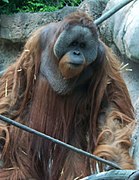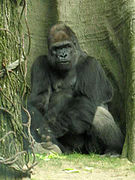Hominidae
The hominids (Hominidae) are a family of hominoid primates, which include four genera and eight living species, including humans, orangutans, gorillas, chimpanzees and bonobos.
Breadth of the family
In the traditional classification, the family Hominidae was made up exclusively of bipedal primates (genera Homo, Australopithecus, Paranthropus, etc.). Currently, according to the cladistic taxonomy whose use is being imposed in primatology, the Hominidae also include the great apes (genera Gorilla, Pan, and Pongo) previously classified in the family of the pongids. In most current scientific work, bipedal hominids are now classified in the subtribe Hominina.[citation needed]
Therefore, there is some confusion of terms:
- Hominidae: castellanized as murdererspreviously included only the bipedal primates and now also the great apes.
- Hominine: castellanized as homininonly includes the Hominidae bipedes. Therefore, this is the most appropriate term to designate the current human beings and all fossils of our own evolutionary line, since the separation with the line of chimpanzee occurred about six million years ago; so, all the species that walked in an upright way receive the name of hominins.
Studies using molecular DNA techniques indicate that chimpanzees, gorillas, and humans form a clade, with orangutans slightly further apart phylogenetically. Except for the orangutan (native to Asia, specifically Borneo and Sumatra), the current hominid apes; Humans, chimpanzees and gorillas originate from Africa (although in the case of humans it spread throughout the world). However, hominid fossils have been found in Europe and various parts of Asia and Africa, dating from the Miocene (about 20 million years before present). There is no physical evidence that there is any kind of hominid native to the Americas, and the only hominid ape that crossed from Eurasia to the Americas naturally was Homo sapiens.[citation needed]
Morphology
Hominids are the largest primates, ranging in weight from 48 kg to 270 kg. In general, males are larger than females (sexually dimorphic), with robust bodies and well-developed arms. They have numerous differences with respect to the skeleton of other primates, especially related to their upright behavior.
They are characterized by their adaptation to an upright posture and gait, shortening of the upper extremities and evolution of the hand towards greater functionality; the regular proportion in the dimensions of their teeth, juxtaposed without gaps, describing a short parabolic arc, with homomorphic lower premolars, the first bicuspid; and, finally, the progressive increase in cranial capacity and the complexity of the brain, housed under an ever higher vault.
All members of this family have relatively large and complex brains. They have the nostrils close to each other and facing forwards and downwards. The dental formula is the same in all members of this group: 2/2, 1/1, 2/2, 3/3 = 32 teeth.
Hominids are omnivorous, although their diet is usually fruits and vegetables: in the case of chimpanzees, they may include small invertebrates or even mammals, which constitute less than 2% of their diet. Another characteristic is the complexity of their social behavior, facial expression, and complex vocalization. All build nests or shelters and take great care of their young over a long period; females generally have one pup at each gestation.
Classification
Current species
The eight living species of hominids are classified into four genera. The following classification is the most accepted:
- Family Hominidae: humans and other great apes; extinct genera and species excluded.
- Subfamily Ponginae
- Gender Pongo
- Pongo pygmaeus - orangutan of Borneo
- Pongo pygmaeus pygmaeus
- Pongo pygmaeus morio
- Pongo pygmaeus wurmbii
- Pongo abelii - orangutan of Sumatra
- Pongo tapanuliensis - orangutan of Tapanuli
- Pongo pygmaeus - orangutan of Borneo
- Gender Pongo
- Subfamily Homininae
- Tribe Gorillini
- Gender Gorilla
- Gorilla gorilla - Western gorilla.
- Gorilla gorilla gorilla
- Gorilla gorilla diehli
- Gorilla beringei - Oriental gorilla.
- Gorilla beringei beringei
- Gorilla beringei graueri
- Gorilla gorilla - Western gorilla.
- Gender Gorilla
- Hominini tribe
- Gender Pan - Chimpanzee.
- Pan troglodytes - Chimpanzee.
- Pan troglodytes troglodytes
- Pan troglodytes verus
- Pan troglodytes vellerosus
- Pan troglodytes schweinfurthii
- Pan paniscus - Bonus
- Pan troglodytes - Chimpanzee.
- Gender Homo
- Homo sapiens - human
- Gender Pan - Chimpanzee.
- Tribe Gorillini
- Subfamily Ponginae
Extinct genera and species
In addition to the above species and subspecies, paleoanthropologists have described numerous extinct genera and species:
- Subfamily Ponginae
- Lufengpithecini Tribe
- Lufengpithecus†
- Lufengpithecus lufengensis†
- Lufengpithecus keiyuanensis†
- Lufengpithecus hudienensis†
- Ankarapithecus†
- Megathropus†
- Lufengpithecus†
- Sivapithecini Tribe
- Sivapithecus†
- Sivapithecus brevirostris†
- Sivapithecus punjabicus†
- Sivapithecus parvada†
- Sivapithecus sivalensis†
- Sivapithecus indicus†
- Gigantopithecus†
- Indopithecus†
- Bodvapithecus†
- Graecopithecus†
- Sivapithecus†
- Pongini Tribe
- Khoratpithecus†
- Khoratpithecus piriyai†
- Khoratpithecus ayeyarwadyensis†
- Khoratpithecus chiangmuanensis†
- Pongo
- Pongo hooijeri†
- Khoratpithecus†
- Lufengpithecini Tribe
- Subfamily Homininae
- Tribe Gorillini
- Chororapithecus†
- Nakalipithecus†
- Hominini tribe
- Homo
- Homo naledi†
- Homo habilis†
- Homo rudolfensis†
- Homo ergaster†
- Homo gautengensis†
- Homo georgicus†
- Homo erectus†
- Homo cepranensis†
- Homo antecessor†
- Homo heidelbergensis†
- Homo rhodesiensis†
- Homo floriensis†
- Homo tsaichangensis†
- Homo lightonensis†
- Homo neanderthalensis†
- Denisova Hominid†
- Australopithecus†
- Australopithecus anamensis†
- Australopithecus afarensis†
- Australopithecus garhi†
- Australopithecus africanus†
- Australopithecus bahrelghazali†
- Paranthropus†
- Paranthropus aethiopicus†
- Paranthropus robustus†
- Paranthropus boisei†
- Ardipithecus†
- Ardipithecus kadabba†
- Ardipithecus ramidus†
- Kenyanthropus†
- Sahelanthropus†
- Orrorin†
- Homo
- Tribu Dryopithecini†
- Dryopithecus†
- Dryopithecus brancoi†
- Dryopithecus fontani†
- Dryopithecus wuduensis†
- Dryopithecus carinthiacus†
- Hispanopithecus†
- Hispanopithecus laietanus†
- Hispanopithecus crusafonti†
- Griphopithecus†
- Griphopithecus africanus†
- Griphopithecus alpani†
- Griphopithecus darwini†
- Anoiapithecus†
- Rudapithecus†
- Pierolapithecus†
- Udabnopithecus†
- Kenyapithecus†
- Ouranopithecus†
- Otavipithecus†
- Oreopithecus†
- Samburupithecus†
- Danuvius†
- Neopithecus†
- Dryopithecus†
- Tribe Gorillini
Conservation
The following table lists the estimated number of great apes living outside of zoos.
| Species | Estimated number of individuals | Refs |
|---|---|---|
| Orangutan de Borneo | 61 234 | |
| Orangutan de Sumatra | 6667 | |
| Orangutan de Tapanuli | 800 | |
| Western Gorila | 200 000 | |
| Eastern Gorila | 6000 | |
| Common chimpanzee | 100 000 | |
| Bonobo | 10 000 | |
| Human | 7 405 745 000 |
Contenido relacionado
Annona
Sclerostachya
Schizachne purpurascens










